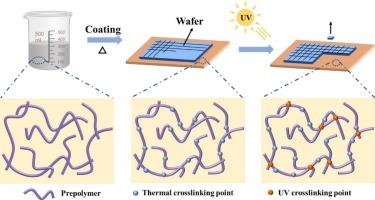UV-induced tack-loss adhesive without residual glue prepared by isocyanate small molecule and acrylate prepolymer containing photoinitiator
IF 5.1
3区 工程技术
Q1 CHEMISTRY, APPLIED
引用次数: 0
Abstract
In the semiconductor precision device processing and wafer cutting industry, products are typically etched or sliced to meet specific requirements. During this process, a novel type of adhesive is often utilized for bonding and securing purposes. After processing, some methods, such as light exposure and thermal application, can be used to make the adhesive lose its adhesiveness, so as to facilitate the peeling of the product without damaging the product. In this work, acrylate prepolymers containing photopolymerization groups were synthesized from 4-acryloyloxybenzophenone (4-ABP) and other acrylic monomers. UV-induced tack-loss of the acrylate pressure-sensitive adhesive (PSA) was achieved by blending the acrylic prepolymer with a small molecule isocyanate compound in an appropriate ratio and then coating for heat curing. It was observed that the incorporation of multifunctional isocyanate small molecule groups can enhance the overall performance of the tape. An addition amount of 0.6 wt% hexamethylene diisocyanate (HDI) was found to be more suitable than isophorone diisocyanate (IPDI), as it maintained good bonding performance and resulted in less residual glue. The increase in 4-ABP initially led to an improvement in bonding performance of the pressure sensitive adhesive tape, followed by a decrease, with an optimal addition amount of 1.2 wt%. After UV curing, the 180° peel strength of the adhesive tape measured below 1.0 N/25 mm, exhibiting the most significant decrease in peel strength and minimal residual adhesive content. This characteristic categorized it as a UV-induced tack-loss easy peeling pressure-sensitive adhesive tape. These results contribute to the further research and development of UV-induced tack-loss PSA.

以异氰酸酯小分子和丙烯酸酯预聚物为光引发剂制备无残胶的紫外光致失胶胶
在半导体精密器件加工和晶圆切割行业中,产品通常被蚀刻或切片以满足特定要求。在这个过程中,一种新型的粘合剂通常用于粘接和固定目的。加工后可采用一些方法,如光照、热敷等,使胶粘剂失去附着力,以利于产品的剥离而不损坏产品。本文以4-丙烯酰氧基二苯甲酮(4-ABP)和其他丙烯酸单体为原料合成了含光聚合基团的丙烯酸酯预聚物。将丙烯酸预聚体与小分子异氰酸酯化合物按适当比例共混,涂覆后进行热固化,实现了丙烯酸酯压敏胶(PSA)的紫外失粘性能。结果表明,多功能异氰酸酯小分子基团的掺入可以提高胶带的整体性能。结果表明,添加量为0.6 wt%的六亚甲基二异氰酸酯(HDI)比添加量为异福尔酮二异氰酸酯(IPDI)更合适,因为它保持了良好的粘合性能,并且残胶量少。4-ABP的增加最初导致压敏胶带粘接性能的改善,随后下降,最佳添加量为1.2 wt%。经UV固化后,胶带的180°剥离强度在1.0 N/25 mm以下,剥离强度下降最显著,残余粘着量最小。这一特性将其归类为紫外线诱导的易脱落的压敏胶带。这些结果有助于进一步研究和开发紫外线诱导的脱胶PSA。
本文章由计算机程序翻译,如有差异,请以英文原文为准。
求助全文
约1分钟内获得全文
求助全文
来源期刊

Reactive & Functional Polymers
工程技术-高分子科学
CiteScore
8.90
自引率
5.90%
发文量
259
审稿时长
27 days
期刊介绍:
Reactive & Functional Polymers provides a forum to disseminate original ideas, concepts and developments in the science and technology of polymers with functional groups, which impart specific chemical reactivity or physical, chemical, structural, biological, and pharmacological functionality. The scope covers organic polymers, acting for instance as reagents, catalysts, templates, ion-exchangers, selective sorbents, chelating or antimicrobial agents, drug carriers, sensors, membranes, and hydrogels. This also includes reactive cross-linkable prepolymers and high-performance thermosetting polymers, natural or degradable polymers, conducting polymers, and porous polymers.
Original research articles must contain thorough molecular and material characterization data on synthesis of the above polymers in combination with their applications. Applications include but are not limited to catalysis, water or effluent treatment, separations and recovery, electronics and information storage, energy conversion, encapsulation, or adhesion.
 求助内容:
求助内容: 应助结果提醒方式:
应助结果提醒方式:


